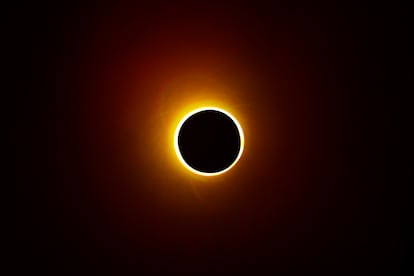Astronomical events in 2023: The best meteor showers, an annular solar eclipse and the year’s biggest moon
Here is an overview of when to expect the night sky’s most impressive natural spectacles


Carl Sagan, the famous researcher who inspired a generation with his scientific rigor, claimed that to contemplate the cosmos was to approach the greatest of mysteries. This year brings unmissable astronomical phenomena, including intense meteor showers, which coincide with the darkness of the new Moon, an eclipse that will appear with a ring of fire in America and three supermoons. As long as the skies are clear, a spectacle in the night sky will be guaranteed.
Lyrid Meteor Shower (April 22 and 23)
Every spring, the Earth passes through a dense cloud of cosmic debris left behind by comet C/1861 G1, which forms the Lyrid shower of stars. This year, the Lyrids’ peak activity coincides with the new moon. In rural areas without light pollution, on the morning of April 23, it will be possible to see up to 20 meteors per hour. The meteor shower’s radiant – the region of the celestial vault where they appear to originate – is in the constellation Lyra, to the north. However, shooting stars can travel any direction in the night sky in fractions of a second.
Supermoon (August 1)
The Moon will be the main attraction of August 2023. One year and one month after the last supermoon, the phenomenon that occurs when the full moon coincides with the closest point of its orbit to Earth, the Moon will appear larger and brighter than normal during the afternoon and evening of August 1. The August full moon was known to Native Americans in the northeast United States as the Sturgeon Moon, as sightings of the species in the Great Lakes region increased during this time.
Perseid Meteor Shower (August 13)
The most popular meteor shower of the summer is shaping up to be one of the most spectacular of 2023. The Perseids will reach their maximum activity during the night of August 12 and the early morning of August 13, causing up to 100 meteors per hour in ideal conditions. With the moon close to its new phase, a clear sky free of light pollution will allow viewers to witness dozens of meteors that seem to originate from the constellation Perseus and travel across the sky.
Super blue moon (August 31)
The brightest full moon of the year will arrive along with the last day of August. At about 221,952 miles away, in contrast to the 238,855 miles that on average separate both stars, Earth’s Moon will appear slightly larger and brighter than the rest of the full moons. This moon will also be peculiar because it is the second full moon in the same month, a phenomenon that happens every 2.5 years, known as the Blue Moon. Despite its name, widely used by NASA for broadcast purposes, the moon’s color will remain unchanged.
Annular solar eclipse (October 14)
The United States, Mexico, Central America, Colombia and the northernmost region of Brazil will witness an annular solar eclipse, a phenomenon in which the Moon will partially block sunlight, causing the appearance of a ring of fire visible mainly in North America, Central America and the Caribbean. The total eclipse will be visible from the west coast and the south of the United States (Oregon, Nevada, New Mexico, Texas), the Gulf of Mexico, Belize, Honduras, Nicaragua, the extreme north of Costa Rica, Panama, Colombia and northern Brazil.
Geminids Meteor Shower (December 13, 14)
After a 2022 in which the peak of the Geminids coincided with the full moon, the most intense meteor shower of the year is shaping up to be one of the unmissable astronomical phenomena of 2023. Although the first Geminids appear in the night sky at the beginning of December, during the middle of the month, cosmic debris from asteroid 3200 Phaethon will increase in intensity, causing a shower of more than 120 meteors per hour starting the night of December 13 and continuing through the early hours of the following day. At more than 21 miles per second, the multicolored Geminid meteors will reward patient observers with a unique celestial spectacle, accompanied by the new moon, whose darkness will facilitate the sighting of shooting stars.
Sign up for our weekly newsletter to get more English-language news coverage from EL PAÍS USA Edition
Tu suscripción se está usando en otro dispositivo
¿Quieres añadir otro usuario a tu suscripción?
Si continúas leyendo en este dispositivo, no se podrá leer en el otro.
FlechaTu suscripción se está usando en otro dispositivo y solo puedes acceder a EL PAÍS desde un dispositivo a la vez.
Si quieres compartir tu cuenta, cambia tu suscripción a la modalidad Premium, así podrás añadir otro usuario. Cada uno accederá con su propia cuenta de email, lo que os permitirá personalizar vuestra experiencia en EL PAÍS.
¿Tienes una suscripción de empresa? Accede aquí para contratar más cuentas.
En el caso de no saber quién está usando tu cuenta, te recomendamos cambiar tu contraseña aquí.
Si decides continuar compartiendo tu cuenta, este mensaje se mostrará en tu dispositivo y en el de la otra persona que está usando tu cuenta de forma indefinida, afectando a tu experiencia de lectura. Puedes consultar aquí los términos y condiciones de la suscripción digital.
More information
Archived In
Últimas noticias
More than 40 Democratic lawmakers urge Trump in a letter to stop his ‘attempts to undermine democracy in Brazil’
The journal ‘Science’ criticizes Trump’s anti-renewable energy policy: ‘The US is failing to benefit from its own innovations’
Cubans hope for a miracle as dengue and chikungunya spread
The long shadow of the father figure in the films of Rob Reiner
Most viewed
- Christian Louboutin: ‘Young people don’t want to be like their parents. And if their parents wear sneakers, they’re going to look for something else’
- Cartels in Mexico take a leap forward with narco-drones: ‘It is criminal groups that are leading the innovation race’
- ‘El Limones’ and the growing union disguise of Mexican organized crime
- Liset Menéndez de la Prida, neuroscientist: ‘It’s not normal to constantly seek pleasure; it’s important to be bored, to be calm’
- The low-cost creative revolution: How technology is making art accessible to everyone










































